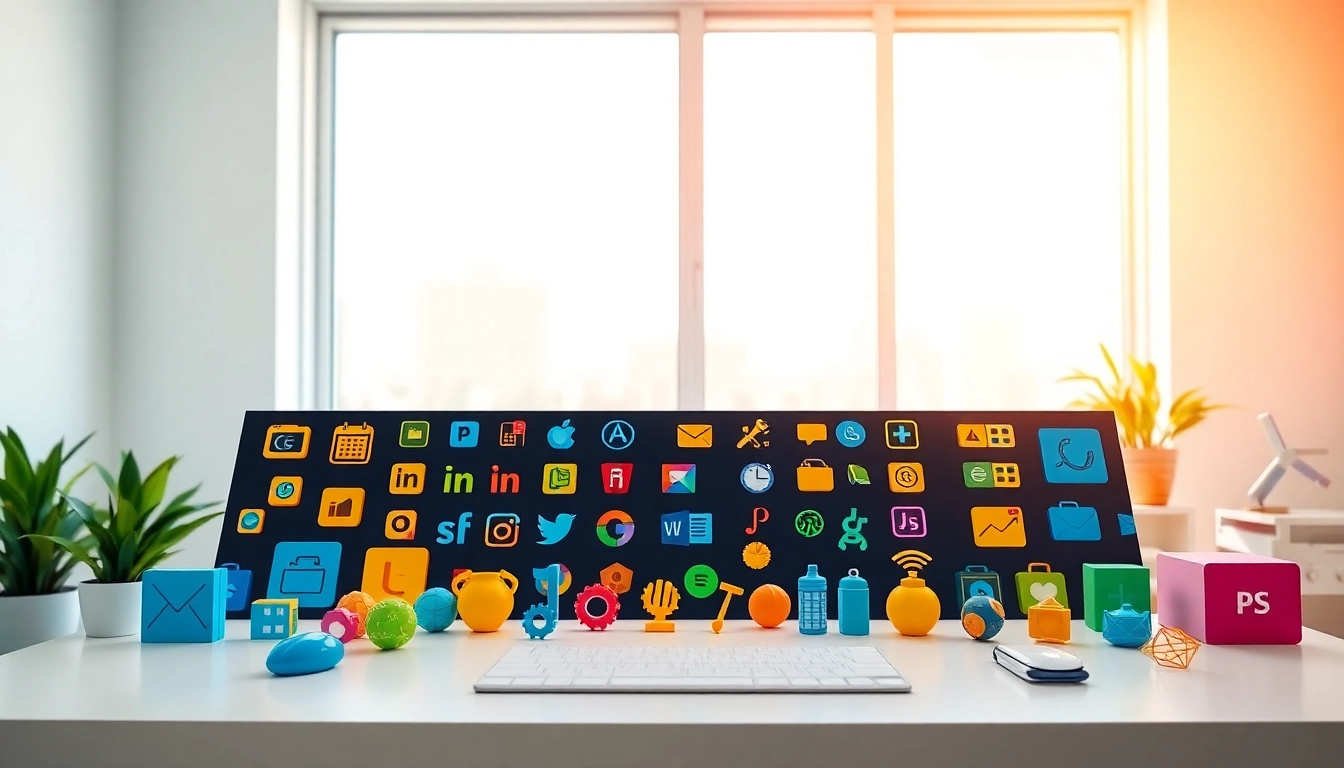Defining Icons and Their Importance
What are Icons?
In the realm of design and digital interfaces, Icons serve as small graphical representations that symbolize a concept, object, or action. Icons can range from simple shapes to complex illustrations and are instrumental in conveying information quickly and efficiently. They are integral to user experience (UX) design, offering visual cues that guide users through an interface, enhancing overall usability.
The Role of Icons in Communication
Icons play a critical role in communication, acting as a universal language that transcends cultural barriers. By reducing the reliance on text, icons can make information more accessible, especially in multilingual environments. For instance, a trash can icon universally indicates a delete function, regardless of the language spoken by the user. This visual shorthand not only enhances clarity but also increases the speed at which information is processed. Furthermore, well-designed icons can create emotional connections, adding a layer of personality to the digital experience.
Types of Icons Used in Design
Icons can be categorized into several types based on their function and aesthetics. Here are a few prevalent categories:
- Static Icons: These are simple images that convey a single specific message, such as a home or settings icon.
- Dynamic Icons: These icons change in appearance based on user interactions, such as hover effects used in web applications.
- Brand Icons: They represent a brand’s identity, such as logos or mascots.
- Social Media Icons: These denote specific platforms (e.g., Facebook, Twitter) and are widely recognized across digital interfaces.
- Emoji Icons: A form of pictograph that has gained traction in digital communication, particularly in mobile and social apps.
Design Principles for Effective Icons
Understanding Iconography
Iconography can be a complex field, requiring a deep understanding of symbols and their meanings. Effective icon design should balance simplicity with clarity to ensure that users understand the icon’s purpose immediately. The best icons simplify concepts without eliminating essential details, allowing for quick recognition and comprehension. For instance, a magnifying glass universally symbolizes search functionality, making it an effective icon for that action.
Color Schemes and Their Impact
Color plays an integral role in icon design and significantly influences user perception. Colors evoke emotional responses and have culturally determined meanings. For example, red can signify danger or urgency, while blue may convey trust and reliability. When selecting a color scheme for icons, designers must consider the overall branding strategy and the specific emotions they wish to invoke in the user. It’s also essential to maintain contrast between icons and their backgrounds to ensure visibility and accessibility.
Size and Clarity Considerations
Icons should be sized appropriately for their intended use. A well-designed icon maintains clarity at various scales, from small mobile screens to large desktop displays. The complexity of the icon should decrease as the size diminishes, ensuring that essential details are not lost. A common best practice is to design icons at @2x or @3x resolutions for high-density displays, enhancing clarity and sharpness regardless of the device or screen size. Additionally, designers should account for spacing around icons to prevent crowding, which can lead to confusion.
How to Create Custom Icons
Tools for Icon Design
Creating custom icons involves using various design tools tailored for graphic design. Popular applications for icon design include:
- Adobe Illustrator: A versatile vector graphics editor widely used by professionals for detailed icon creation.
- Sketch: This tool is favored for user interface and icon design due to its ease of use and collaboration capabilities.
- Figma: A web-based application that allows for collaborative design processes and real-time editing.
- Canva: An accessible online graphic design tool that provides various templates and elements for quick icon creation.
Steps to Create Your Own Icons
Designing custom icons involves several critical steps:
- Research and Brainstorm: Understand the purpose of the icon and gather inspiration, analyzing existing icons to identify successful features.
- Sketching: Create rough sketches to explore different concepts before moving to digital design.
- Digital Design: Utilize design software to create the icon, focusing on clarity, simplicity, and alignment with established design principles.
- Feedback and Revision: Solicit feedback from users and stakeholders, making revisions based on constructive criticism to improve the icon’s functionality and appeal.
- Finalization: Prepare the icon for use, exporting it in various formats (such as SVG or PNG) for different applications.
Testing and Iterating Icon Designs
Testing is a vital component in icon design. User testing can reveal whether an icon is universally understood or if it needs additional context. Iteration based on feedback can refine the icon’s features and enhance its effectiveness. It’s advisable to conduct A/B testing when implementing icons in a live environment to measure user responses and determine which designs resonate best with the audience. Engaging with users allows designers to make data-driven decisions that resonate better with the intended audience.
Using Icons in Digital Spaces
Integration into User Interfaces
The integration of icons into user interfaces should enhance navigation and not confuse users. Icons should be used in tandem with text labels to clarify their meanings, especially in complex applications. Studies have shown that the combination of icons and text can increase comprehension and retention rates among users. Furthermore, consistency in icon style throughout an interface is crucial; varying icon styles can lead to confusion and diminish the user experience.
Best Practices for Using Icons in Websites
When incorporating icons into websites, designers should adhere to several best practices:
- Keep It Simple: Avoid overcrowding pages with icons; a sparse, purposeful approach leads to better user navigation.
- Test Visibility: Ensure icons are visible on various devices and screen sizes by using appropriate contrast and sizing.
- Maintain Consistency: Use a unified style for icons across the site to create a cohesive brand identity.
- Prioritize Accessibility: Design with accessibility in mind, ensuring that icons are understandable to all users, including those with disabilities.
Icons in Mobile Applications
Mobile applications heavily rely on icons due to limited screen space. The design of mobile icons must prioritize instant recognition and functionality. Icons should be touch-friendly, meaning they must be large enough to be tapped easily without requiring precision. Usability testing is essential for mobile applications to ensure icons provide the intended user actions and navigate smoothly. Furthermore, context is crucial; mobile icons should be placed where users naturally expect them, such as a trash can icon in the delete area.
Trends in Icon Design
Current Styles and Trends
As technology advances, so do icon design trends. Currently, several styles are gaining popularity:
- Flat Design: A minimalist aesthetic that uses simple shapes and bold colors, focusing on functionality without unnecessary embellishments.
- Line Icons: Thin, outlined icons that are versatile and modern, often used in responsive web and mobile designs.
- 3D Icons: Increasingly, designers are adopting three-dimensional effects to create depth and a sense of realism.
- Animated Icons: These are becoming prevalent as they draw attention and create engaging experiences without overwhelming the user.
Responsive Icons for Modern Devices
With the rise of various devices and screen sizes, responsive design is vital for icons. Icons must adapt fluidly to different resolutions and orientations. Techniques such as scalable vector graphics (SVG) allow for high-quality icons that maintain their resolution regardless of screen size. Additionally, utilizing CSS media queries can help alter the icon size and layout dynamically, ensuring consistency and usability across diverse devices.
Future Directions in Icon Design
The future of icon design is expected to include even greater emphasis on personalization and user-centric design. With AI and machine learning becoming more integrated into design processes, icons may soon adapt dynamically to user preferences and behaviors. As voice interfaces and augmented reality continue to evolve, icons must also adapt to these technologies, possibly transforming into more intuitive and interactive elements that blend seamlessly with the user’s experience.



